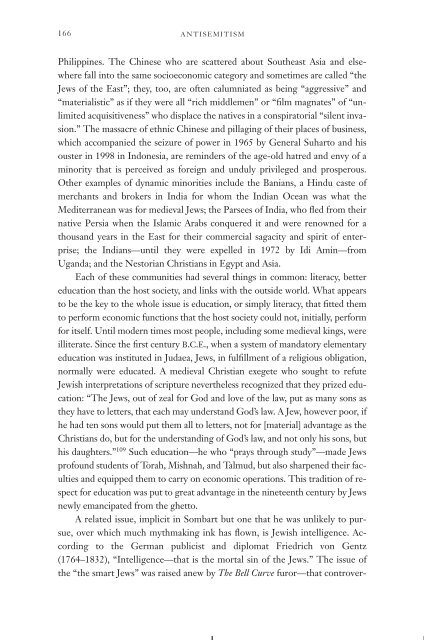41845358-Antisemitism
41845358-Antisemitism
41845358-Antisemitism
Create successful ePaper yourself
Turn your PDF publications into a flip-book with our unique Google optimized e-Paper software.
166 ANTISEMITISM<br />
Philippines. The Chinese who are scattered about Southeast Asia and elsewhere<br />
fall into the same socioeconomic category and sometimes are called “the<br />
Jews of the East”; they, too, are often calumniated as being “aggressive” and<br />
“materialistic” as if they were all “rich middlemen” or “film magnates” of “unlimited<br />
acquisitiveness” who displace the natives in a conspiratorial “silent invasion.”<br />
The massacre of ethnic Chinese and pillaging of their places of business,<br />
which accompanied the seizure of power in 1965 by General Suharto and his<br />
ouster in 1998 in Indonesia, are reminders of the age-old hatred and envy of a<br />
minority that is perceived as foreign and unduly privileged and prosperous.<br />
Other examples of dynamic minorities include the Banians, a Hindu caste of<br />
merchants and brokers in India for whom the Indian Ocean was what the<br />
Mediterranean was for medieval Jews; the Parsees of India, who fled from their<br />
native Persia when the Islamic Arabs conquered it and were renowned for a<br />
thousand years in the East for their commercial sagacity and spirit of enterprise;<br />
the Indians—until they were expelled in 1972 by Idi Amin—from<br />
Uganda; and the Nestorian Christians in Egypt and Asia.<br />
Each of these communities had several things in common: literacy, better<br />
education than the host society, and links with the outside world. What appears<br />
to be the key to the whole issue is education, or simply literacy, that fitted them<br />
to perform economic functions that the host society could not, initially, perform<br />
for itself. Until modern times most people, including some medieval kings, were<br />
illiterate. Since the first century B.C.E., when a system of mandatory elementary<br />
education was instituted in Judaea, Jews, in fulfillment of a religious obligation,<br />
normally were educated. A medieval Christian exegete who sought to refute<br />
Jewish interpretations of scripture nevertheless recognized that they prized education:<br />
“The Jews, out of zeal for God and love of the law, put as many sons as<br />
they have to letters, that each may understand God’s law. A Jew, however poor, if<br />
he had ten sons would put them all to letters, not for [material] advantage as the<br />
Christians do, but for the understanding of God’s law, and not only his sons, but<br />
his daughters.” 109 Such education—he who “prays through study”—made Jews<br />
profound students of Torah, Mishnah, and Talmud, but also sharpened their faculties<br />
and equipped them to carry on economic operations. This tradition of respect<br />
for education was put to great advantage in the nineteenth century by Jews<br />
newly emancipated from the ghetto.<br />
A related issue, implicit in Sombart but one that he was unlikely to pursue,<br />
over which much mythmaking ink has flown, is Jewish intelligence. According<br />
to the German publicist and diplomat Friedrich von Gentz<br />
(1764–1832), “Intelligence—that is the mortal sin of the Jews.” The issue of<br />
the “the smart Jews” was raised anew by The Bell Curve furor—that controver-


